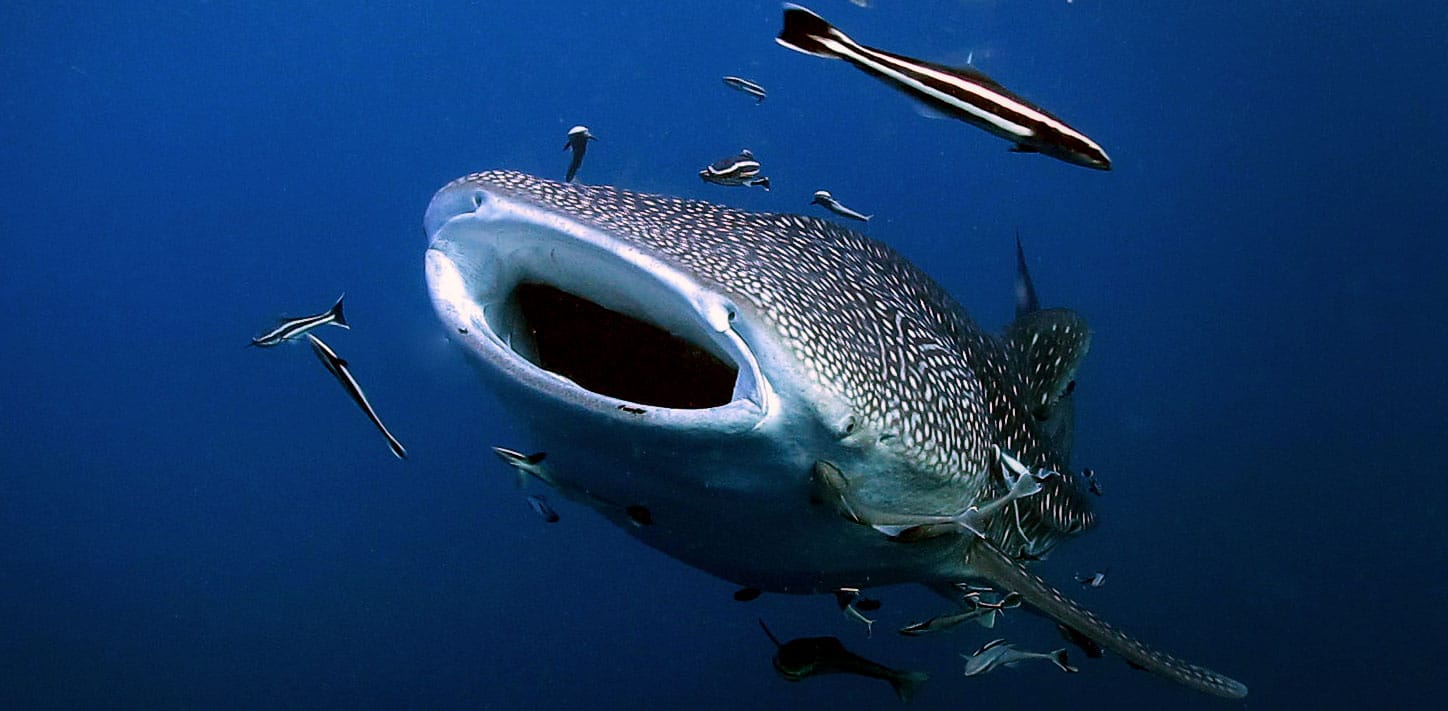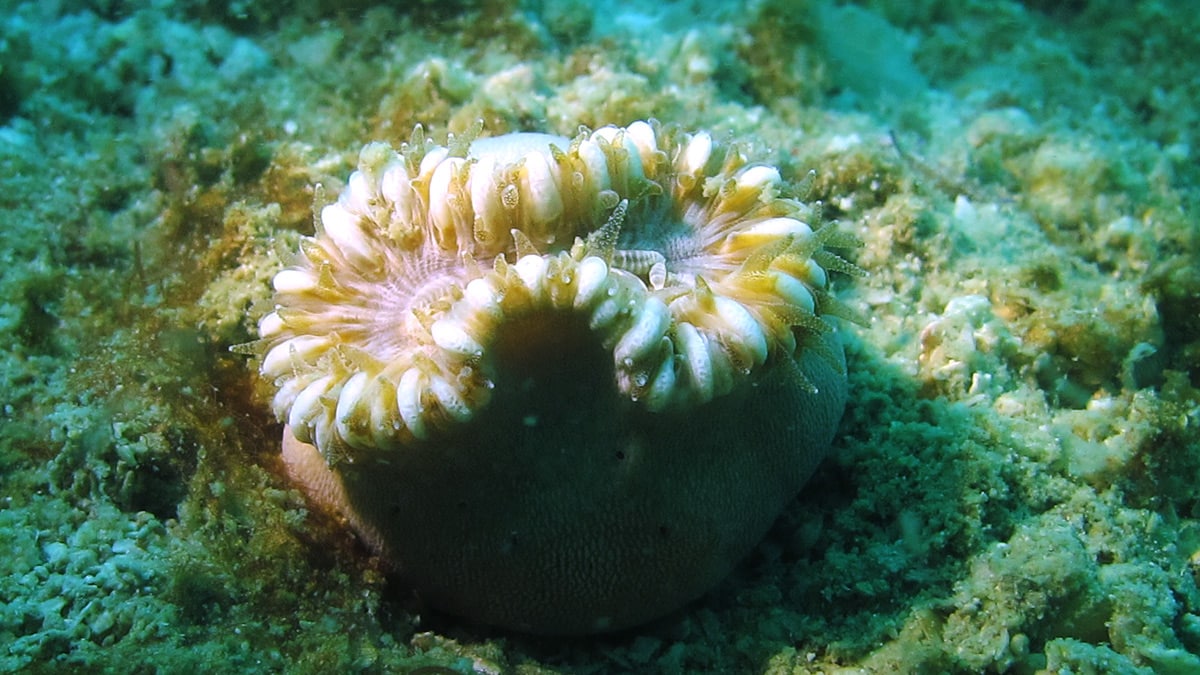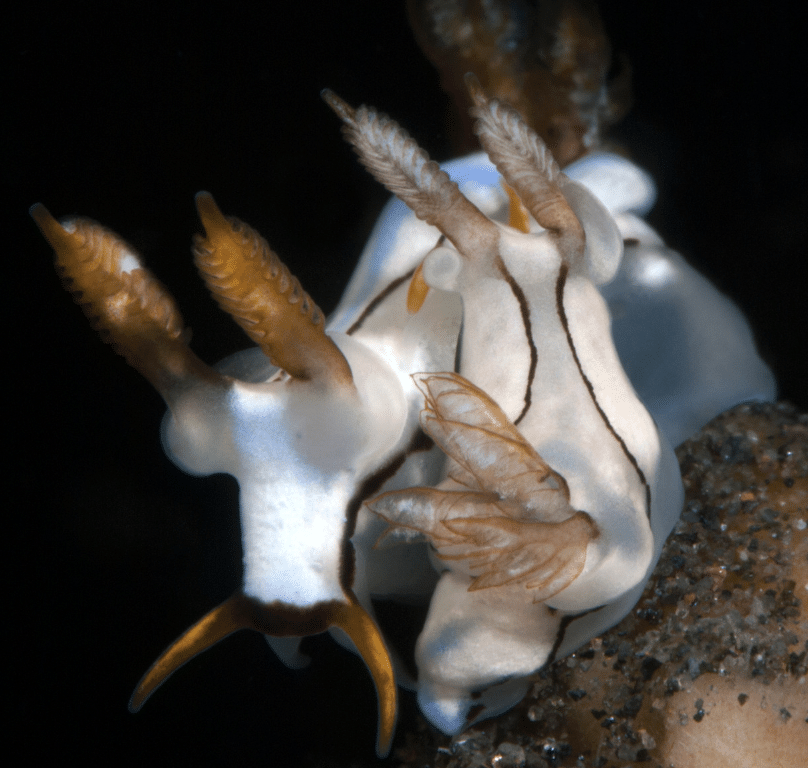Saving Thailand's Gentle Giants: How Divers Protect Whale Sharks
Swimming with the ocean’s largest fish is an experience that changes the lives of any diver lucky enough to have the encounter. Thailand's whale sharks bring in an untold number of visitors each year, but data shows their populations are declining.
Now, divers and other marine enthusiasts are actively helping professionals to understand and protect these gentle giants through photo databases. Anybody with a camera can capture images of the spot patterns of the whale sharks, which can then be used for identification, much like fingerprints. Groups like Thai Whale Sharks then use that data to track populations and inform local managers and policy-makers.
Whale sharks are found in warm waters worldwide, but their numbers are declining – they’re now classified as endangered. Threats to whale sharks include targeted fishing, accidental fishing (known as bycatch), boat collisions, and entanglement.
To protect these migratory animals, scientists need to understand better where they travel to and from and where they carry out various stages of their reproduction and development. But, collecting such data has historically been difficult and expensive.
That’s why Conservation Diver and partners have recently harnessed the power of citizen science to investigate populations of Thailand's whale sharks.
Here, we’ll bring you up to speed on citizen science, break down the collected data, and explain how it can help the conservation of whale sharks.

What is citizen science?
Citizen science is the science carried out voluntarily by members of the public. So, how can it be used to monitor whale shark populations?
Just like humans have their own individual fingerprints, whale sharks have their unique spot patterns. This means that photos of whale sharks can be used to assess whale shark numbers and monitor individuals over time.
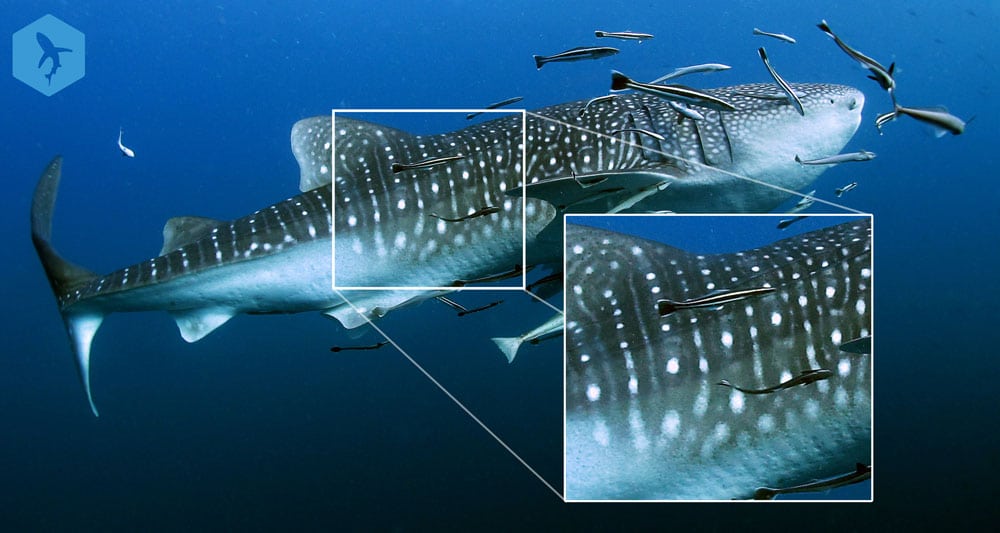
What’s more, whale sharks are incredibly popular among camera-wielding scuba divers. Cameras that are getting cheaper and better every year. Fortunately, this means that there are heaps of snaps of whale sharks out there.
Members of the public can then upload these whale shark photos to a photo-identification software library. This can tell us key information about the whale shark, like whether it’s male or female or even whether it’s been involved in a boat collision.
Moreover, if multiple photos of the same whale shark are submitted, we can learn even more about whale shark behavior. For instance, it’s possible to determine a whale shark’s annual migration patterns.
From 2004 to 2019, 247 whale shark sightings were recorded around the three islands of Koh Tao, Koh Samui and Koh Phangan to Koh Tao Whalesharks/Thai Whalesharks. Overall, 178 whale sharks were identified, and some individuals were spotted more than once.
From this data, Kirsty Magson of the New Heaven Reef Conservation Program and Conservation Diver led a team to publish a paper in the Journal of Fish Biology titled “Citizen Science Reveals the Population Structure and Seasonal Presence of Whale Sharks in the Gulf of Thailand.”
What did the study on Thailand's whale sharks show?
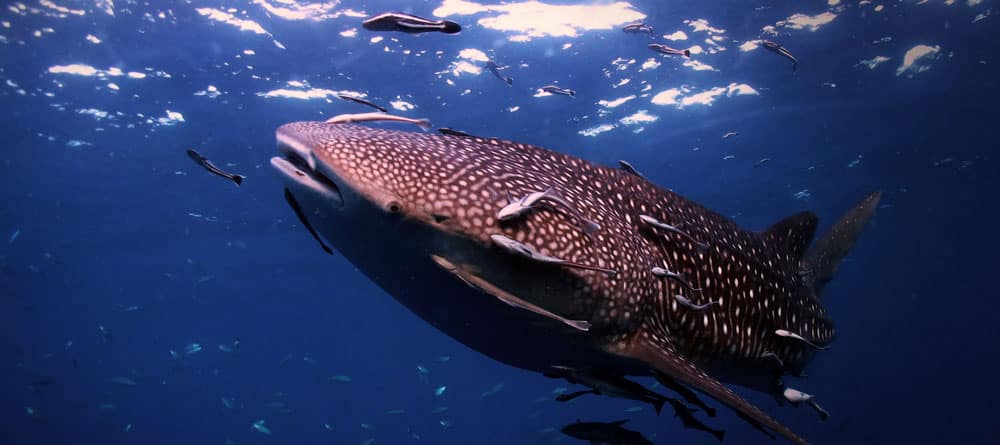
Whale shark size, sex, and scars
All the whale sharks sighted in the area were <6 meters long, making them juveniles. The average total length of whale sharks observed was 3.7 meters.
Sex was only reported for 27% of sightings; however, more female whale sharks were spotted than males (19% were female, and 8% were male).
Scars were reported for 28 individual whale sharks (16%). Fortunately, most of these, such as facial abrasions, were considered minor (79%).
Major scarring included loss of the dorsal fin. These were thought to have been caused by boat collisions and entanglement (for instance, in discarded fishing nets).

Whale shark movements and seasonality
The results highlight a peak in sightings of whale sharks in Thai water during April–May (35% of sightings) and another peak in October and November (23% of sightings).
Some whale sharks were sighted more than once, and one was in another country (Malaysia). The time between the initial sightings and resighting varied from less than one week to more than two years.
Statistical analysis of the data provided further insights. For instance, the whale shark population lost and gained members over time (known as an ‘open population’).
Additionally, some whale sharks showed signs of annual periodicity – this means that whale sharks returned to a site at regular intervals. However, all whale sharks eventually left their site completely.
Whale shark migration routes typically stretch for thousands of kilometers, and the researchers concluded that the monitored sites were used as a pit stop for whale sharks traveling long distances.
How can these data help to protect Thailand's whale sharks?
Of course, the data described here wasn’t generated in a laboratory and isn’t perfect. For instance, the peak sighting season of April to May coincides with a busy holiday period. This means that a great number of sightings could partly reflect a greater number of tourists with cameras in the area.
Nonetheless, these data provide some key insights that will help to plan further scientific investigations and, ultimately, protective policies.
For instance, most whale shark aggregations are formed mainly of males, but protecting juvenile female sharks is critical for population recovery.
Here, more females than males were sighted (at a 2:1 ratio). Therefore, these data provide further evidence of the need to protect the female-heavy whale shark population that frequents the Gulf of Thailand.
Additionally, 24 of the sighted whale sharks in Thailand were scarred or injured, including missing dorsal fins and rope tied around their tail. Rope often becomes entangled around whale shark tails when ropes are used to drag whale sharks out of nets.
It’s encouraging that whale sharks are being released. However, these observations indicate that part of the rope may remain attached to the shark, causing long-term injury or disadvantaging the individual.
Therefore, these data highlight the need for improved methods of releasing caught whale sharks.
How can I help?
The great news is that anyone can contribute to this research! All you need to do is upload your snaps to the Whaleshark Project (global) or the Thai Whale Sharks Facebook Page (Thailand) after you’ve been swimming with whale sharks.

The database uses technology similar to facial recognition to match the individual to the ones featured in previously submitted photos. If no matches exist, a whole new profile will be generated for that individual.
The website also features a super handy code of conduct for Thailand's whale shark diving – check it out so you can ensure you act responsibly when encountering one of these majestic creatures.
If you’re keen to dive a little deeper into the study's findings, you can find the original article here.
An Update on an Itinerant Family of Corals: Dendrophylliidae
A recent publication has shed new light on one of the more diverse and exciting families of corals, Dendrophylliidae. A reorganization of the family is underway using new molecular and imaging techniques and is helping to uncover the evolutionary history of its many species.
The title of this article uses the adjective ‘itinerant,’ which is generally not a word you associate with hard corals, who tend not to wander much. But it fits Dendrophylliidae for multiple reasons. For example, its included genus Heteropsammia, also known as the ‘Walking Dendros,’ which lives on the back of worms and cruises around the sands like kids on dirt bikes. Or, the genus Tubastraea, the only Scleractinian to successfully make it from the Pacific to the Atlantic in the last few million years. As we learn more about the systematics and history of this family, we discover more about the path it has taken to become such an exciting group today.
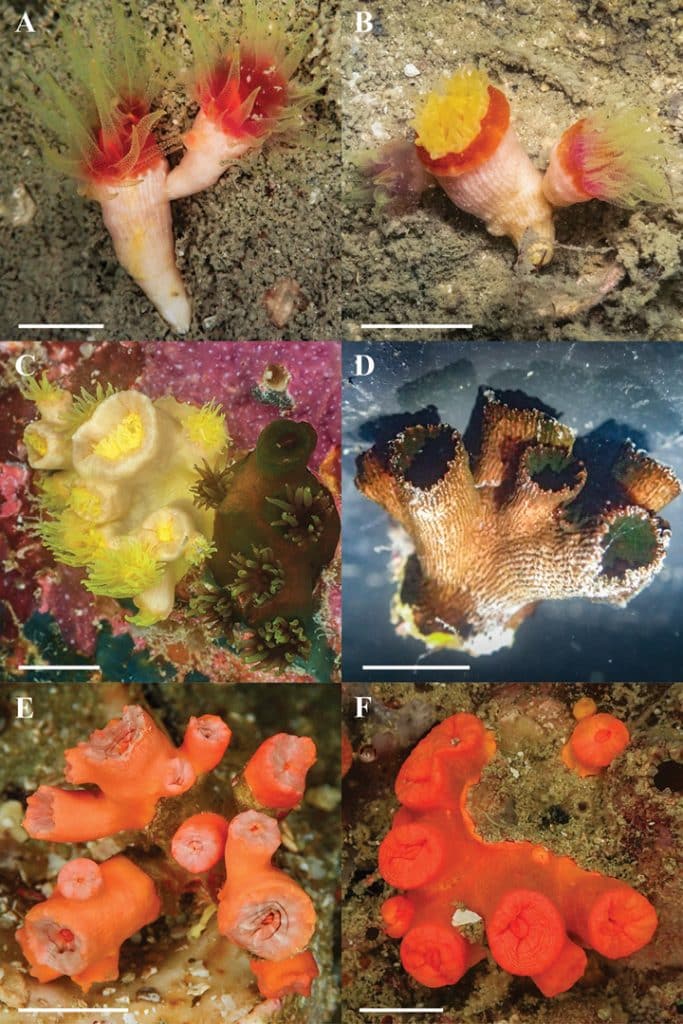
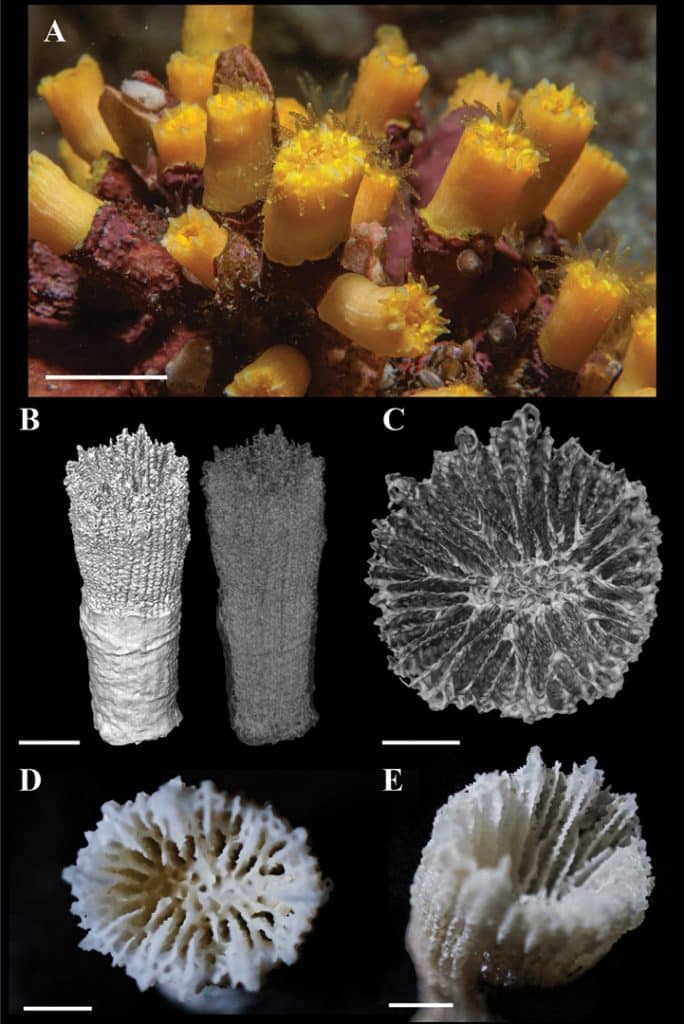
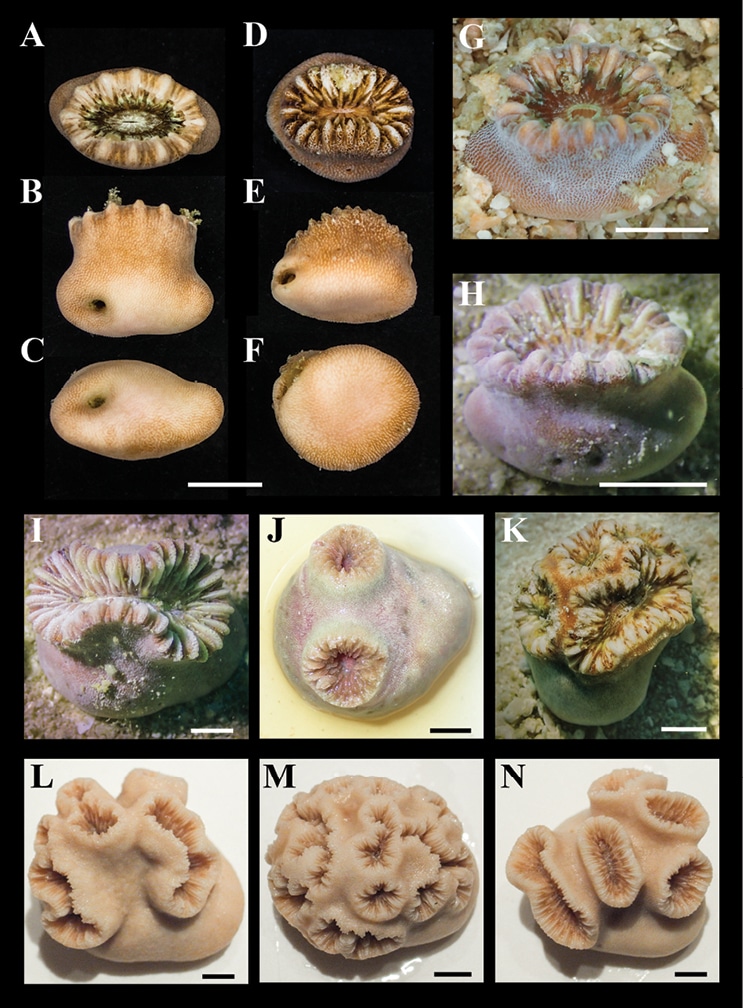

A New Look at the Family Dendrophylliidae
Dendrophylliidae is the third most diverse family of hard corals, with around 183 species. They are an Indo-Pacific group of the order Scleractina but are often non-reef building and azooxanthellate. To date, they have been classified primarily for their apparent morphological features, recently proven in other groups of corals to be quite unreliable and in need of revision.
This last month, Dr. Rahul Mehrotra and several other members and friends of Conservation Diver published a paper in the journal Contributions to Zoology that used DNA testing and high-resolution micro CT scans to propose a new phylogenetic hypothesis of the group. The paper led to many new and interesting findings about an already exciting family of corals, as we will explore here.
Heteropsammia: AKA the “Walking Dendro”
The first coral genera we have to discuss is, of course, Heteropsammia ("Hetero-" from the Greek ἕτερος (héteros) meaning "different" or "other," and "psammia" from the Greek ψάμμος (psámmos), "sand"). This small, inconspicuous coral forms a symbiosis with both a sipunculid worm (peanut worm) and a parasitic mussel. This worm helps it move around the soft bottom areas it inhabits and avoid being buried by sediment, forming an obligate mutualistic relationship. But how does this relationship even start?

According to Corals of the World, the coral larvae settle on a microgastropod shell out in the silt off the reef. Then, it forms an “obligate commensal relationship” with the worm (Aspidosiphon corallicola) as well as the mussel (Lithophaga lessepsiana), who lives directly above the worm. This is a fascinating observation, but it leaves so many obvious and burning questions completely unanswered. How does this relationship even start? Who links up with whom? Does the coral settle on the worm, or does the worm burrow into the coral? And when does the mussel move in to join this odd couple?
I reached out to Dr. Mehrotra, who explained it further. He said larvae of Heteropsammia settle only on the gastropod shell, and as the coral grows, the shell is left poking out of the side of the juvenile coral. Next, as nobody has confirmed it, he suspects that the worm moves into the shell and takes up residence there. Because the coral larvae form aggregations, it’s likely the worm (which he pointed out is actually Aspidosiphon muelleri) is able to detect and reproduce in a way that facilitates this cycle to occur in mass. He also mentioned that the parasitic mollusk is not always present and was never present in the ones he looked at from the Gulf.
So, still a lot of answered questions there, and hopefully, an investigation that a future student will pick up. It would be fascinating to do spawning and development experiments with both the coral and the worm in our future coral-slug lab on a private Pacific island funded by curious billionaires.
What else was learned about Heteropsammia?
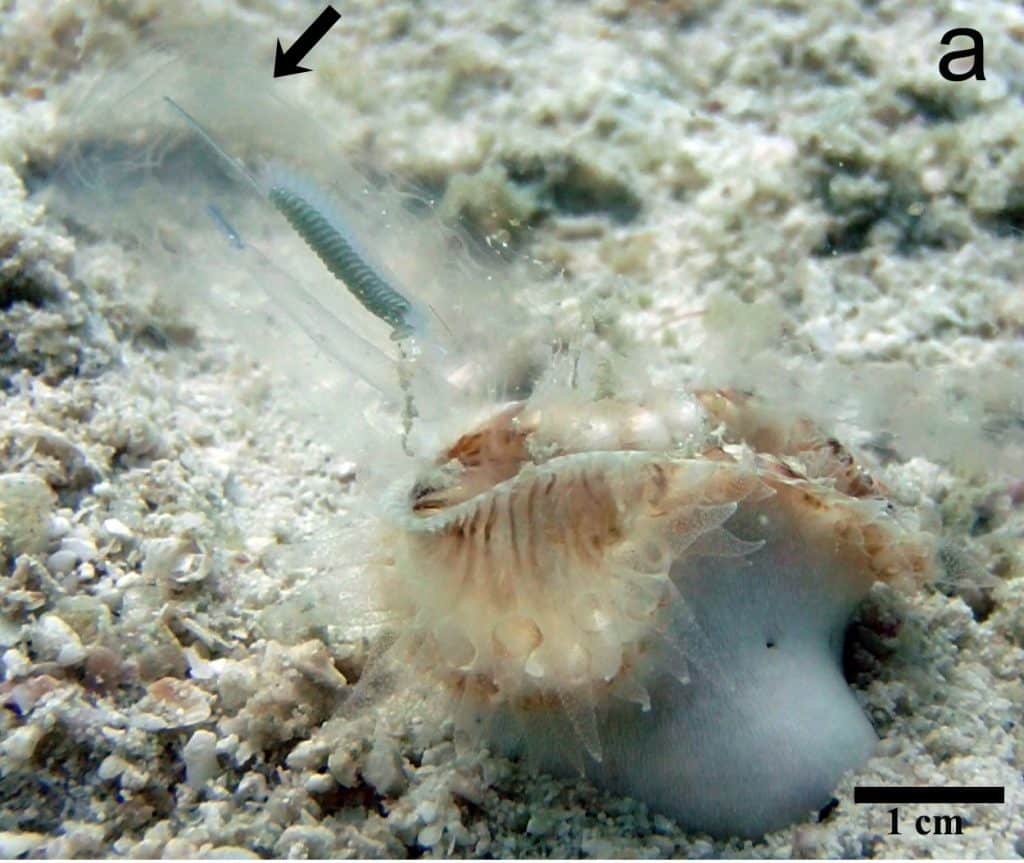
Heteropsammia is no stranger to our team. In 2015 we published how they consumed sea salps much larger than themselves, not with their tentacles, but instead by opening their mouth really wide and using their digestive filaments (new horror movie idea, anyone?). Then, in 2019, we included them in our feeding trial paper investigating heterotrophy in corals and their ability to eat sea slugs (this time having some manners and using their tentacles).
This new paper not only helps to reorganize the species within Heteropsammia more accurately, it also made several new mind-blowing observations. First, in addition to hosting the sipunculid, one coral also was found to host a comfy little hermit crab in the worm’s burrow (a first for Koh Tao), and another was found to be hosting a beautiful but parasitic epitoniid snail (think Wentletrap). It also added several new items to the ‘list of things we have seen them eat,’ including more sea slugs (rest in peace Costasiella), an anemone, and even a whole jellyfish. Wow.

Tubastrea: the world traveler
Tubastraea ("Tuba" from the Latin word for "tube" and "Astrea" from the Latinized form of the Greek "Astraea,” referring to star-like shapes) are known for their bright colors and huge corallites. They are conspicuous corals found throughout the Indo-Pacific, often in areas with poor light (overhangs, caves, turbid waters, etc.). They can grow to incredible sizes, but their azooxanthellate nature means their skeleton is thin and brittle, often not contributing to reef growth.

Feeling a bit of wanderlust, two species of Tubastraea (T. coccinea and T. tagusensis) stowed away in the bilge water of a boat traveling through the Panama Canal in the early 1980s. Since then, they have successfully colonized this new ocean, setting up along more than 3,500 km of coastline in the Atlantic and Caribbean. According to genetic analysis, the word is out, and several more migrations have occurred since the first pioneers made their way over. They now hold the record as the only Scleractinian with populations in both oceans.
As cosmopolitan as they are, there is still so much we don’t know about them and their habits. This new paper saw them doing strange things (while confirming or reclassifying many species). First, a colony was found cooperatively eating a sea pen (Pennatulacean), with two coral polyps holding down the sea pen while the third ate it. This is the first recorded observation of an Anthozoan eating another Anthozoan. The brutal gang behavior of Tubastrea must now be well known in the area, as the team did not find any parasites, predators, symbionts, or epibionts on the corals they observed.
Other findings from the ‘muck.’
Besides thoroughly examining the family Dendrophylliidae in the Gulf of Thailand, the paper highlights the overlooked soft-sediment, or muck, habitats. Recreational diving in the region is primarily confined to the near-shore fringing reefs or the scattered submerged pinnacles dotting the Gulf. As such, most of the attention has been placed there, and in the face of climate change, this is not unwarranted.
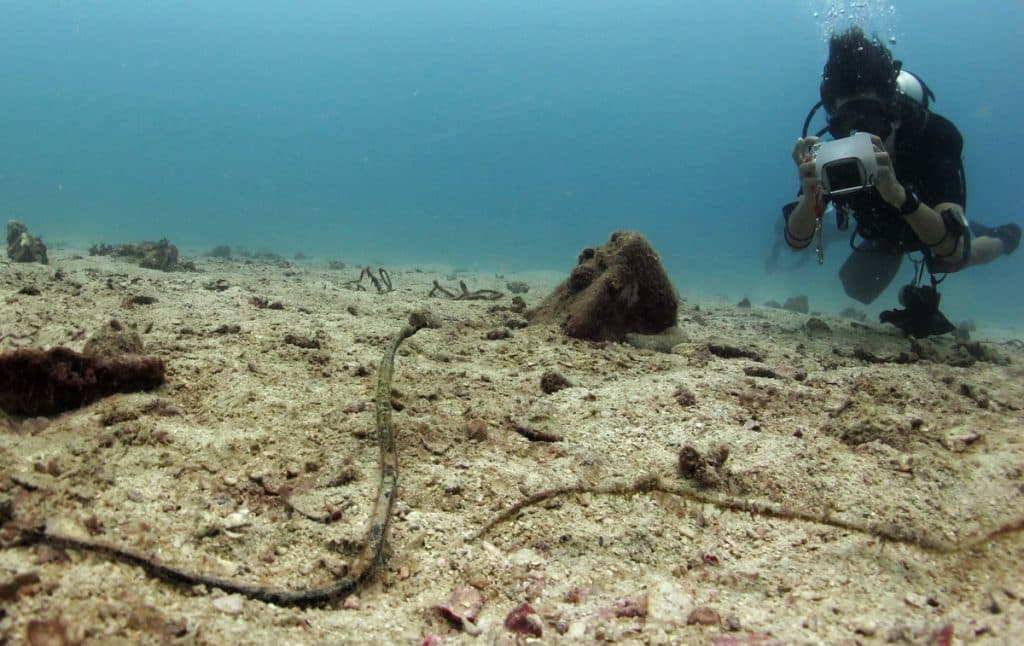
But, a largely unexplored and overlooked treasure trove of biodiversity exists in the muddy plains that comprise much of this ancient submerged basin. New and exciting organisms, relationships, feeding habits, and survival mechanisms await observation, pondering, and learning.
Based on observations from around the region, the team predicts that two more genera of Dendrophyllids are waiting to be found in the area. It is hoped that bringing attention to the natural riches of these areas will increase public demand for protection and help aid in their continued survival.
Please check out the full paper, Biodiversity, ecology, and taxonomy of sediment-dwelling Dendrophylliidae (Anthozoa, Scleractinia) in the Gulf of Thailand, by Rahul Mehrotra, Suchana Chavanich, Coline Monchanin, Suthep Jualaong, & Bert W. Hoeksema.
Sea Slug Diversity in Koh Tao, Thailand
An extensive 14-year study using benthic surveys and photographic records has revealed a stunning richness of sea slug diversity around the island of Koh Tao, Thailand. A staggering 191 distinct species across the orders Sacoglossa (14 species), Cephalaspidea (23 species), Aplysiida (5 species), Pleurobranchida (3 species), and Nudibranchia (146 species). Among these, seven species are the first of their kind reported in the Gulf of Thailand, while an additional 115 species represent the first records for Thailand as per current literature.
These findings have arisen through the dedication and hard work of many citizen science divers, enthusiasts, and local photographers under the direction of Dr. Rahul Mehrortra. Rahul worked for many years with the New Heaven Reef Conservation Program, was a founding board member of Conservation Diver, and then started his center, the Aow Thai Marine Ecology Center (ATMEC), in partnership with the Love Wildlife Foundation.
Over more than a decade, he has led many studies resulting in eight scientific publications to date:
- Predation on a sacoglossan gastropod by a mushroom coral. R Mehrotra, CM Scott, JM Rohrer, BW Hoeksema - Coral Reefs, 2015
- Species inventory of sea slugs (Gastropoda: Heterobranchia) for Koh Tao, Thailand, with 25 first records for Thai waters. R Mehrotra, CM Scott - Marine Biodiversity, 2016.
- On the genus Armina (Gastropoda: Heterobranchia: Nudibranchia) in Thailand. R Mehrotra, M Caballer Gutierrez, S Chavanich - Marine Biodiversity, 2017
- Selective consumption of sacoglossan sea slugs (Mollusca: Gastropoda) by scleractinian corals (Cnidaria: Anthozoa). R Mehrotra, C Monchanin, CM Scott, N Phongsuwan… - PLoS One, 2019
- The formerly enigmatic Unidentiidae in the limelight again: a new species of the genus Unidentia from Thailand (Gastropoda: Nudibranchia). T Korshunova, R Mehrotra, S Arnold, K Lundin… - Zootaxa, 2019
- A new species of coral-feeding nudibranch (Mollusca: Gastropoda) from the Gulf of Thailand. R Mehrotra, S Arnold, A Wang, S Chavanich… - Marine Biodiversity, 2020
- On the Plakobranchidae (Gastropoda, Sacoglossa) from soft sediment habitats of Koh Tao, Gulf of Thailand, with descriptions of two new species. R Mehrotra, MC Gutiérrez, CM Scott, S Arnold… - ZooKeys, 2020
- An updated inventory of sea slugs from Koh Tao, Thailand, with notes on their ecology and a dramatic biodiversity increase for Thai waters. R Mehrotra, MAC Gutiérrez, CM Scott, S Arnold… - ZooKeys, 2021

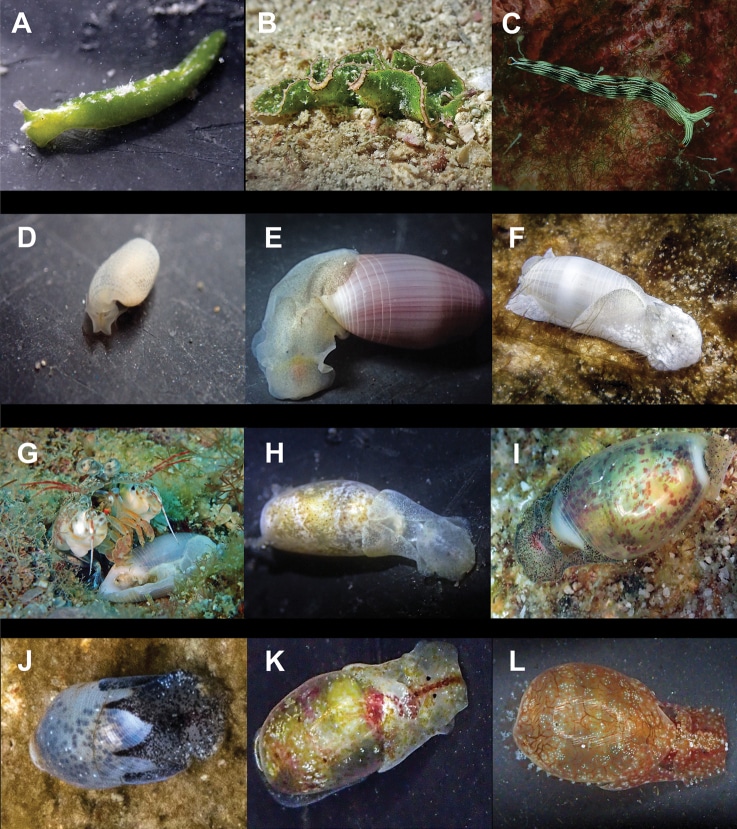

A Rich Biodiversity of sea slugs
The abundance of species diversity for an island of Koh Tao's size is unusually high. Yet, these studies have shown that most species were sighted infrequently and often had limited geographic ranges, highlighting the need for continued surveying and monitoring. Significantly, many species were discovered in non-reef areas, indicating that these regions harbor greater biodiversity than previously understood. This suggests the potential for promoting non-coral reef tourism, particularly as the local coral reefs face threats from overuse by SCUBA divers.
New Species Descriptions
In addition to the wider study of sea slug diversity, several focused studies were conducted. The Indo-Pacific genus Phestilla, which has been a subject of ongoing taxonomic debate, was re-evaluated. A previously unknown species of Phestilla was discovered feeding on Pavona explanulata, a coral species, in Koh Tao. This observation sparked a fresh discussion about this genus's position, and the ecological implications of its coral-parasitic behavior.
Finally, the sea slug heterobranch fauna of Thailand, with a total of 191 species, has seen an intriguing development. Two new species of the genus Armina were discovered in Thailand, distinct from the only previously recorded Armina semperi. Armina scotti, and Armina occulta. are described in detail, highlighting their unique morphological features and contributing to our understanding of the complex and diverse world of sea slugs.
New Understanding Of Trophic Functions
Another study unveiled the surprising revelation that some reef corals consume sea slugs. The feeding trials involved six species of sacoglossan sea slugs and four species of solitary corals. The results showed significant differences in both the time of ingestion and consumption state among the different sea slug species. Prey size was a crucial factor, with larger prey being ingested more slowly and rarely than smaller ones. This study paves the way for a deeper understanding of coral diet, highlighting the significant differences between opportunistic prey capture and actual predation events.
A Diverse Hot-spot for Sea Slugs
These studies shed light on the overlooked richness of marine biodiversity in non-reef areas and underscore the importance of continuous exploration and research in understanding and preserving marine life around Koh Tao and beyond. The constant evolution of taxonomy and species reclassification demands consistent monitoring and updated records, thereby setting the stage for a more comprehensive and accurate understanding of marine biodiversity.

